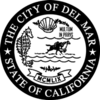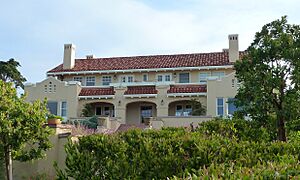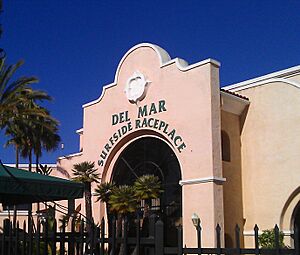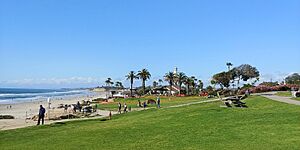Del Mar, California facts for kids
Quick facts for kids
Del Mar, California
|
||
|---|---|---|
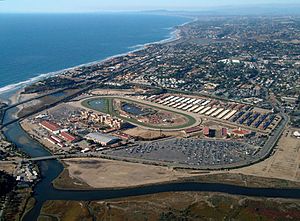
The Del Mar racetrack
|
||
|
||
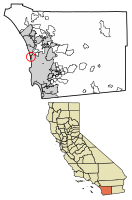
Location of Del Mar in San Diego County, California
|
||
| Country | ||
| State | ||
| County | ||
| Incorporated | July 15, 1959 | |
| Government | ||
| • Body | City council | |
| Area | ||
| • City | 1.77 sq mi (4.59 km2) | |
| • Land | 1.72 sq mi (4.45 km2) | |
| • Water | 0.06 sq mi (0.14 km2) 3.94% | |
| Elevation | 112 ft (34 m) | |
| Population
(2020)
|
||
| • City | 3,954 | |
| • Density | 2,302.85/sq mi (889.19/km2) | |
| • Metro | SD-TJ: 5,105,768 | |
| Time zone | UTC-8 (PST) | |
| • Summer (DST) | UTC-7 (PDT) | |
| ZIP code |
92014
|
|
| Area code(s) | 858 | |
| FIPS code | 06-18506 | |
| GNIS feature ID | 1656480 | |
Del Mar (which means "Of the Sea" in Spanish) is a beautiful beach city. It is located on the coast of the Pacific Ocean in San Diego County, California. The city started in 1885 as a fun seaside resort. It officially became a city in 1959. In 2020, about 3,954 people lived there.
Del Mar is famous for a few big events. The San Diego County Fair happens every year at the Del Mar Fairgrounds. Also, exciting horse racing events take place at the Del Mar Racetrack each summer.
Contents
Del Mar's Interesting History
Del Mar was first settled in the early 1880s. A railroad official named Theodore M. Loop and his wife, Ella, were among the first. Ella gave the place its name, inspired by a poem.
In 1885, Colonel Jacob Taylor bought about 338 acres (1.37 km²) of land. He dreamed of building a fancy seaside resort for rich and famous people.
During World War II, the United States Navy used Del Mar. They had a special air facility for blimps there.
Today, Del Mar faces challenges from the ocean. Many homes are near the coast and cliffs. These areas can be affected by rising sea levels. The city is working on plans to protect its coast. They are using methods like building seawalls and adding sand to the beaches.
The Surf Line railroad tracks run along the coast. They are next to cliffs that are about 40 feet (12 meters) high. These cliffs slowly wear away each year. To keep the tracks safe, steel beams were put into the beach in 2020. The city is also looking for ways to make sure people can safely reach the beach.
Geography and Nature in Del Mar
Del Mar is a special place for a rare tree called the Torrey pine. It's one of only two places in the world where these pines grow naturally. The Torrey pine is the rarest pine tree in the United States.
At the southern edge of Del Mar, you'll find the Los Peñasquitos Lagoon. To the north is the San Dieguito Lagoon and the San Dieguito River. This river flows into the Pacific Ocean right at Del Mar.
The city's total area is about 1.8 square miles (4.7 km²). Most of this is land, with a small part being water.
Del Mar's Climate
Del Mar has a pleasant mediterranean climate. This means it has warm, dry summers and mild, wet winters. Temperatures usually stay comfortable. They rarely go above 85°F (29°C) or below 41°F (5°C). The average temperature is around 65°F (18°C). Del Mar often has foggy mornings because it's between two lagoons and right by the Pacific Ocean.
People Living in Del Mar
| Historical population | |||
|---|---|---|---|
| Census | Pop. | %± | |
| 1960 | 3,124 | — | |
| 1970 | 3,956 | 26.6% | |
| 1980 | 5,017 | 26.8% | |
| 1990 | 4,860 | −3.1% | |
| 2000 | 4,389 | −9.7% | |
| 2010 | 4,161 | −5.2% | |
| 2020 | 3,954 | −5.0% | |
| U.S. Decennial Census | |||
Population in 2020
In 2020, the population of Del Mar was 3,954 people. Most residents were White. There were also people of Asian, Black, and other backgrounds. About 9.9% of the population identified as being of two or more races. Around 14.4% of the people were Hispanic or Latino.
Population in 2010
In 2010, Del Mar had 4,161 residents. The city had about 2,064 households. Many households were families, including married couples. The average household had about two people. The average family had about 2.5 people.
The population included people of all ages. About 13.6% were under 18 years old. About 20.8% were 65 years or older. The average age in Del Mar was 48.6 years.
Education in Del Mar
Kids in Del Mar attend schools in the Del Mar Union School District. This district has eight schools for students from kindergarten to 8th grade. For high school, students go to schools in the San Dieguito Union High School District.
Getting Around Del Mar
The North County Transit District offers bus service called BREEZE. Del Mar used to have a train station that served the Amtrak San Diegan service. This station closed in 1995. Now, people use the Solana Beach Transit Center, which is two miles north. This station provides Coaster commuter trains and Amtrak's Pacific Surfliner service. This train line is one of the busiest in the United States.
The railroad tracks are next to coastal cliffs. Because these cliffs are eroding, there are plans to move the train line further inland. This project is being studied to find the best way to keep the tracks safe.
Fun Things to Do in Del Mar
- Del Mar Racetrack: You can watch live horse races here in the summer and fall. The fairgrounds also host other racing events throughout the year.
- San Diego County Fair: A big annual fair with rides, food, and entertainment.
- Torrey Pines State Beach: A beautiful beach and nature reserve where you can see the rare Torrey pine trees.
- Powerhouse Community Center: A place for community events and activities.
- Del Mar Antiques + Art + Design Show: A show held three times a year for over 50 years, featuring antiques, art, and design.
- North Beach Area (also known as "Dog Beach"): A popular spot for people to bring their dogs.
Famous People from Del Mar
Many well-known people have lived in or have ties to Del Mar:
- Desi Arnaz: An actor and musician.
- Burt Bacharach: A famous songwriter.
- Drew Brees: A successful quarterback for the New Orleans Saints.
- Rachel Buehler: A defender for the United States women's national soccer team.
- Martin Cooper: Known for inventing the first handheld mobile phone.
- Tom DeLonge: A guitarist and founding member of the band Blink-182.
- Jimmy Durante: A famous entertainer who lived on the beach for many years.
- Steve Fisher: A former basketball coach at San Diego State University.
- Rachael Flatt: A former figure skater and Olympian.
- Bill Gates: The co-founder of Microsoft Corporation.
- Tony Hawk: A world-famous skateboarder and entrepreneur.
- Sara Jacobs: A US Congresswoman.
- Nate Kaeding: A former placekicker for the San Diego Chargers.
- Charles David Keeling: A scientist known for his work on climate change.
- George Emil Palade: A Nobel Prize winner.
- Carson Palmer: A former NFL quarterback.
- Ardem Patapoutian: A 2021 Nobel Prize laureate.
- Steve Perry: The former lead singer of the rock band Journey.
- Aaron Rodgers: A quarterback for the Green Bay Packers.
- Willie Shoemaker: A famous jockey.
- Norv Turner: A former head coach of the San Diego Chargers.
Images for kids
See also
 In Spanish: Del Mar para niños
In Spanish: Del Mar para niños


